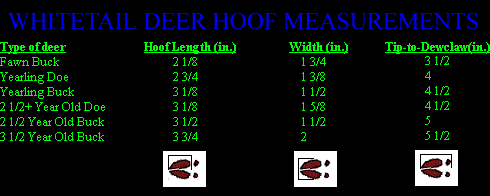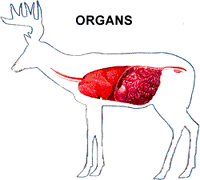HERE YOU WILL FIND MANY
USEFUL TIPS AND OR TACTICS THAT MAY HELP YOU
GET YOUR BUCK THIS YEAR..
| Tracks | Lyme Disease | Field Dressing | Scoring | Blood Trailing | Aging Your Deer |
![]()


| Tips for the Beginning Bowhunter
This is only intended to help a young bowhunter not to be used as a set of rules that one must follow. |
|
|
Take a Bowhunter Education Course This is an excellent program for
both beginning and experienced archers. Taking this course can save you
years of trial and error in the field. These courses are taught by
qualified instructors that will share their knowledge and help you become
an effective bowhunter. You can discover where and when a course
will be available in your area by contacting your local archery club, pro
shop or bowhunting association.
Practice, Practice, Practice This section cannot be emphasized enough. Only by practice will you be able to become a pro-efficient bowhunter and increase your chance of a clean kill. Practice on the archery field to get your bow tuned and to determine your effective shooting range. Practice regularly and under any weather condition on the 3-D walk around range. This will allow you to shoot under more realistic hunting conditions and sharpen your skills as an effective archer. Improperly judged distances are
probably a major factor in missed shots. Thus, proper range estimation
is the must for successful bowhunting. Range estimation can be learned
through experience gained from stump shooting and 3-D shooting. Note
that after every practice shot taken the actual range should be taken as
to learn and adapt.
Scent and Wind There are a lot of products our today that are designed to cover or mask the human scent. Even though the products may be effective and help you elude the animal longer than it would usually be possible, it is not an excuse for ignoring the wind direction. The keys to staying undetected are keeping your movement minimal, making the least noise possible and preventing the animals from detecting sent. Of all these, scent is the one that will usually give you away. This is because you have less control of your odor and no control of the wind. It is important that you stay downwind of your pray to decrease its chances of detecting you. Bear in mind that the wind direction
can change and keeping track of such changes is a must . . .
There are many ways to determine the direction of even the lightest breezes.
Some hunters use butane lighters, others use a fine scentless powder that
will float with the wind, while others attach a small feather onto a string
of floss and attach it to their bow. Any method will do as long as
it is quite, requires little movement and releases little or no scent.
Scouting In order to complete a successful
hunt, you must know as much about your prey as possible. You must
learn of the animal's habits, food sources and travel routes. Scouting
a good portion of the year is a trait associated with many successful bowhunters
and they will tell you that the information and experience gained from
this habit is invaluable. Also note that over scouting an area can
have a negative effect on the wildlife and you may end up pushing the animals
out of the area or may become nocturnal, not be seen or heard from during
hunting hours.
Hunt Safely Archery is probably the safest of
all shooting sports, yet accidents do happen and it is up to you to be
prepared. Broadheads are sharp and should always be protected, do
not leave the sharp edges exposed. Treestands are notably dangerous
and have even been the cause of death in some bowhunting accidents.
The use of a harness is a must if you plan to hunt from a treestand.
Always carry some emergency supplies in case you get lost or hurt, this
includes your compass. Even if you follow every single one of the
tip, there is always a chance that something may go wrong. Whenever
you wander into the wilderness, be prepared for the worst.
Don't Over-Hunt an Area. Just like over-scouting, over hunting an area can also have a negative impact. Every time you come back and forth from your ground blind or treestand, you leave scent behind that can alert passing game. Too many hunters in one area will eventually scare the animals out of that area or force them to become nocturnal. To minimize over-hunting an area,
try to have more than one possible location for your treestand. Deer
can adapt, if you use the same site every day they will associate it with
humans. Once they associate a site with humans, they will avoid it
and warn other deer as well. Try to avoid areas where hunting pressure
is already great. Don't forget to always keep your scent to a minimal.
So don't pass a game trail on the way to your tree stand or walk parallel
to existing game trails.
Tracking skills Getting a shot on an animal is one of the greatest accomplishments for a beginning bowhunter. Unfortunately there is still much work to do after you release that arrow. Finding the downed animal is one of the most important of them. Tracking the animal can be a challenge in itself, but add that to a rainy day, falling daylight or a bloodless trail and then you could end up with a nightmare. Fortunately most bowhunters education courses teach a young bowhunter how to track animals after a shot. This will aid you greatly in getting a grasp of the art. Also try to bring in an experienced hunter to help you locate the animal. With his experience you increase the chance of a recovery and learn valuable tips while doing it.
|
A MORE ADVANCED TIPS SECTION IS GOING TO BE ADDED SOON!
GO BACK TO PAGE ONE
|